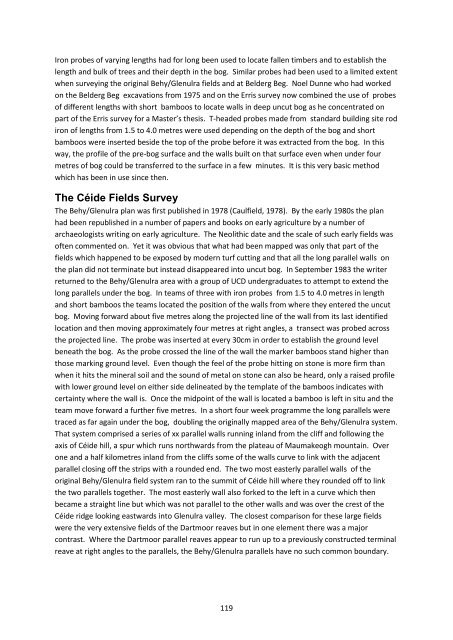Neolithic and Bronze Age Landscapes of North Mayo: Report 2011
Neolithic and Bronze Age Landscapes of North Mayo: Report 2011
Neolithic and Bronze Age Landscapes of North Mayo: Report 2011
You also want an ePaper? Increase the reach of your titles
YUMPU automatically turns print PDFs into web optimized ePapers that Google loves.
Iron probes <strong>of</strong> varying lengths had for long been used to locate fallen timbers <strong>and</strong> to establish the<br />
length <strong>and</strong> bulk <strong>of</strong> trees <strong>and</strong> their depth in the bog. Similar probes had been used to a limited extent<br />
when surveying the original Behy/Glenulra fields <strong>and</strong> at Belderg Beg. Noel Dunne who had worked<br />
on the Belderg Beg excavations from 1975 <strong>and</strong> on the Erris survey now combined the use <strong>of</strong> probes<br />
<strong>of</strong> different lengths with short bamboos to locate walls in deep uncut bog as he concentrated on<br />
part <strong>of</strong> the Erris survey for a Master’s thesis. T-headed probes made from st<strong>and</strong>ard building site rod<br />
iron <strong>of</strong> lengths from 1.5 to 4.0 metres were used depending on the depth <strong>of</strong> the bog <strong>and</strong> short<br />
bamboos were inserted beside the top <strong>of</strong> the probe before it was extracted from the bog. In this<br />
way, the pr<strong>of</strong>ile <strong>of</strong> the pre-bog surface <strong>and</strong> the walls built on that surface even when under four<br />
metres <strong>of</strong> bog could be transferred to the surface in a few minutes. It is this very basic method<br />
which has been in use since then.<br />
The Céide Fields Survey<br />
The Behy/Glenulra plan was first published in 1978 (Caulfield, 1978). By the early 1980s the plan<br />
had been republished in a number <strong>of</strong> papers <strong>and</strong> books on early agriculture by a number <strong>of</strong><br />
archaeologists writing on early agriculture. The <strong>Neolithic</strong> date <strong>and</strong> the scale <strong>of</strong> such early fields was<br />
<strong>of</strong>ten commented on. Yet it was obvious that what had been mapped was only that part <strong>of</strong> the<br />
fields which happened to be exposed by modern turf cutting <strong>and</strong> that all the long parallel walls on<br />
the plan did not terminate but instead disappeared into uncut bog. In September 1983 the writer<br />
returned to the Behy/Glenulra area with a group <strong>of</strong> UCD undergraduates to attempt to extend the<br />
long parallels under the bog. In teams <strong>of</strong> three with iron probes from 1.5 to 4.0 metres in length<br />
<strong>and</strong> short bamboos the teams located the position <strong>of</strong> the walls from where they entered the uncut<br />
bog. Moving forward about five metres along the projected line <strong>of</strong> the wall from its last identified<br />
location <strong>and</strong> then moving approximately four metres at right angles, a transect was probed across<br />
the projected line. The probe was inserted at every 30cm in order to establish the ground level<br />
beneath the bog. As the probe crossed the line <strong>of</strong> the wall the marker bamboos st<strong>and</strong> higher than<br />
those marking ground level. Even though the feel <strong>of</strong> the probe hitting on stone is more firm than<br />
when it hits the mineral soil <strong>and</strong> the sound <strong>of</strong> metal on stone can also be heard, only a raised pr<strong>of</strong>ile<br />
with lower ground level on either side delineated by the template <strong>of</strong> the bamboos indicates with<br />
certainty where the wall is. Once the midpoint <strong>of</strong> the wall is located a bamboo is left in situ <strong>and</strong> the<br />
team move forward a further five metres. In a short four week programme the long parallels were<br />
traced as far again under the bog, doubling the originally mapped area <strong>of</strong> the Behy/Glenulra system.<br />
That system comprised a series <strong>of</strong> xx parallel walls running inl<strong>and</strong> from the cliff <strong>and</strong> following the<br />
axis <strong>of</strong> Céide hill, a spur which runs northwards from the plateau <strong>of</strong> Maumakeogh mountain. Over<br />
one <strong>and</strong> a half kilometres inl<strong>and</strong> from the cliffs some <strong>of</strong> the walls curve to link with the adjacent<br />
parallel closing <strong>of</strong>f the strips with a rounded end. The two most easterly parallel walls <strong>of</strong> the<br />
original Behy/Glenulra field system ran to the summit <strong>of</strong> Céide hill where they rounded <strong>of</strong>f to link<br />
the two parallels together. The most easterly wall also forked to the left in a curve which then<br />
became a straight line but which was not parallel to the other walls <strong>and</strong> was over the crest <strong>of</strong> the<br />
Céide ridge looking eastwards into Glenulra valley. The closest comparison for these large fields<br />
were the very extensive fields <strong>of</strong> the Dartmoor reaves but in one element there was a major<br />
contrast. Where the Dartmoor parallel reaves appear to run up to a previously constructed terminal<br />
reave at right angles to the parallels, the Behy/Glenulra parallels have no such common boundary.<br />
119

















